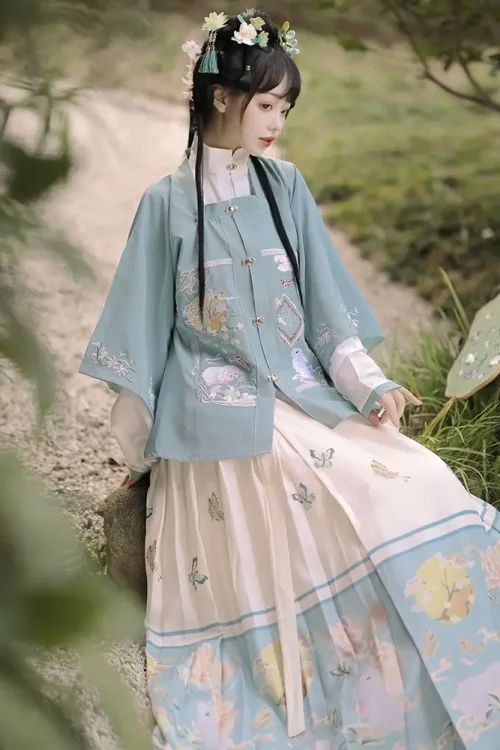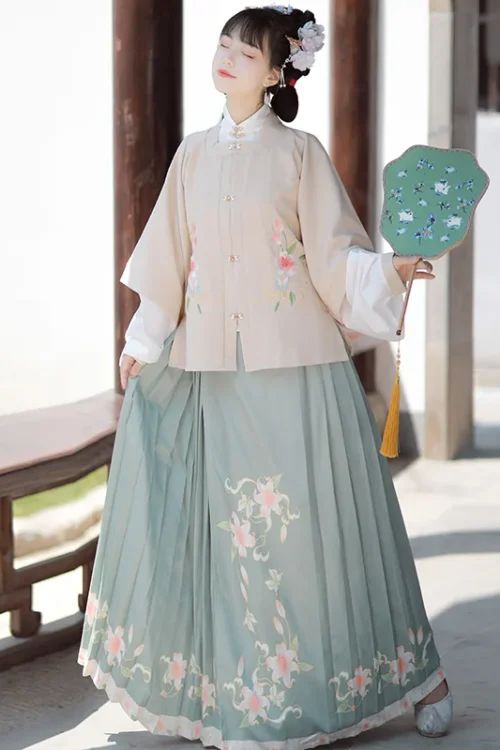The Allure of Ming-Dynastie Hanfu for Weddings: A Timeless Tradition
Ming Dynasty Hanfu: A Timeless Tradition for Special Occasions
The Ming Dynasty (1368-1644) witnessed a resurgence of Hanfu, the traditional clothing of the Han Chinese. During this period, Hanfu reached its peak of elegance and sophistication, becoming an integral part of Chinese culture and society.

Significance in Weddings
For special occasions, such as weddings, festivals, and religious ceremonies, Ming Dynasty Hanfu took on a particularly elaborate and symbolic significance. Weddings were a time for brides and grooms to showcase their finest Hanfu, adorned with intricate embroidery, vibrant colors, and flowing fabrics.

- Bride’s Hanfu: Typically consisted of a long, flowing robe known as a “ruqun,” often made of silk or brocade, featuring elaborate embroidery depicting auspicious symbols such as dragons, phoenixes, and flowers.
- Groom’s Hanfu: More subdued, typically consisting of a long robe and a matching hat.
Role in Festivals and Ceremonies
Beyond weddings, Hanfu also played a significant role in festivals and religious ceremonies.
- Lantern Festival: People wore colorful Hanfu to watch lantern displays and participate in traditional games.
- Dragon Boat Festival: Hanfu was worn to commemorate the poet Qu Yuan and to ward off evil spirits.
Cultural Reflection
The Ming Dynasty Hanfu was not merely a fashion statement but also a reflection of Chinese cultural values and beliefs.
- Symbolism: Intricate embroidery and vibrant colors symbolized prosperity, happiness, and good fortune.
- Elegance and Tradition: Flowing fabrics represented elegance and grace, while traditional designs paid homage to Chinese history.
Modern Influence
Today, the Ming Dynasty Hanfu continues to inspire modern fashion designers and cultural enthusiasts. Its timeless beauty and cultural significance have ensured its enduring legacy as a symbol of Chinese heritage and tradition. Whether for weddings, festivals, or other special occasions, the Ming Dynasty Hanfu remains a testament to the enduring allure of Chinese culture.
Embracing Ming Dynasty Hanfu for Festivals: A Celebration of Culture and Heritage
Ming Dynasty Hanfu: Adorning Special Occasions with Cultural Elegance
The Ming Dynasty, renowned for its cultural achievements, left an enduring legacy in the form of Hanfu, traditional Chinese clothing that embodies the era’s aesthetics and values. Beyond its everyday use, Hanfu played a pivotal role in special occasions, adding grandeur and cultural significance to weddings, festivals, and other celebrations.

Weddings and Symbolism
Weddings, the most auspicious of life events, were adorned with elaborate Hanfu.
- Bride’s Attire: Known as the “Qun,” featuring a long, flowing skirt and an embroidered jacket.
- Groom’s Attire: Wore a “Pao,” a long robe with wide sleeves, symbolizing the couple’s union and their hopes for a prosperous future.
Festivals and Cultural Immersion
Festivals were a time for Hanfu to shine.
- Lantern Festival: People celebrated in vibrant Hanfu, illuminating the streets with colorful lanterns.
- Dragon Boat Festival: Participants donned Hanfu while engaging in traditional races and enjoying festive delicacies.
Other Special Occasions
Hanfu also graced other special occasions:
- Formal Ceremonies: Scholars and officials wore Hanfu, showcasing their status and respect for tradition.
- Performing Arts: Traditional operas and dances featured Hanfu, enhancing the visual spectacle and conveying stories.
A Connection to Heritage
Embracing Ming Dynasty Hanfu for special occasions is not merely a fashion statement but a celebration of Chinese culture and heritage. It connects individuals with the past, appreciating traditional aesthetics and fostering cultural identity.
Revival of Interest
In recent years, there has been a growing revival of interest in Hanfu, particularly among young people. This resurgence is driven by a desire to reconnect with Chinese traditions and to express cultural pride. By embracing Ming Dynasty Hanfu for special occasions, individuals contribute to this cultural revival, ensuring this timeless tradition continues to thrive.
Beyond Weddings and Festivals: Exploring the Versatility of Ming Dynasty Hanfu for Special Occasions
Ming Dynasty Hanfu: A Tapestry of Elegance for Special Occasions
Beyond the grandeur of weddings and the vibrancy of festivals, Ming Dynasty Hanfu unveils its versatility as exquisite attire for a myriad of special occasions. Its intricate designs, flowing fabrics, and rich symbolism elevate any event to a realm of timeless elegance.

Formal Gatherings
For formal gatherings, such as banquets and receptions, the Ming Dynasty Hanfu exudes an air of sophistication.
- Shenyi: A long robe with wide sleeves, adorned with intricate embroidery, paired with a “Pipa,” a long skirt.
- Dafu: A more elaborate version of the Shenyi, reserved for prestigious occasions, reflecting the wearer’s status and honor.
Religious Ceremonies
During religious ceremonies and ancestral rituals, the Ming Dynasty Hanfu serves as a sacred garment.
- Jiaoling: A robe with a cross-collar, worn by priests and officials, symbolizing their connection to the divine.
- Daopao: A long robe with wide sleeves, donned by Taoist practitioners, representing the fluidity of the Tao.
Festive Celebrations
For festive celebrations, such as the Lantern Festival and the Dragon Boat Festival, the Ming Dynasty Hanfu transforms into a vibrant expression of joy and tradition.
- Huafu: A colorful and ornate robe worn by women, reflecting the festive spirit.
- Wufu: A more casual version popular among children, adding a playful touch to the festivities.
Performing Arts
The versatility of the Ming Dynasty Hanfu extends to the performing arts. In traditional Chinese opera, Hanfu is integral to costumes, enhancing performers’ movements and expressions.
Symbol of Cultural Heritage
The Ming Dynasty Hanfu has become a symbol of cultural heritage and national pride. In recent years, there has been a resurgence of interest in this traditional attire, with people wearing it to express their connection to their ancestors and celebrate their cultural identity.
Fazit
In conclusion, the Ming Dynasty Hanfu is not merely a garment but a testament to the artistry and cultural significance of a bygone era. Its versatility extends far beyond weddings and festivals, making it an exquisite choice for a wide range of special occasions. As a symbol of elegance, tradition, and cultural heritage, the Ming Dynasty Hanfu continues to captivate and inspire, weaving a tapestry of timeless beauty and cultural significance.
